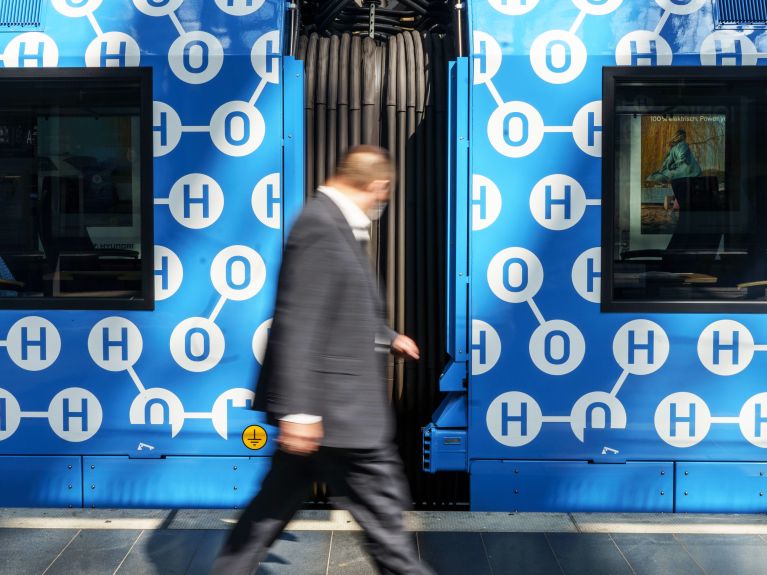“Pooling strengths”
Matthias Bauer, a chemist, explains how German and French researchers hope to improve the production of green hydrogen.

Green hydrogen plays a key role in the energy transition. German and French researchers have teamed up to improve the eco-balance of the hydrogen production process. The Deutsche Forschungsgemeinschaft (German Research Foundation – DFG) and its French partner Agence nationale de la recherche are providing just shy of one million euros to fund the work of researchers from the French cities of Strasbourg, Metz and Nancy and from Berlin and Paderborn in Germany. The project is being run by Paderborn-based chemist Professor Matthias Bauer, whose research has been devoted to the topic of sustainability for years.

production of green hydrogen.
© Universität Paderborn/Besim Mazhiqi
Professor Bauer, what is your new approach to producing green hydrogen?
As things currently stand, green hydrogen is generated indirectly with electricity, typically through the electrolysis of water. This involves using electricity produced by solar or wind power to run the electrolysers. Though this technology has already been around for a long time and is highly efficient, I see this process as being a detour. Instead, the primary energy from the sun could be used by converting sunlight directly into chemical energy. Nature shows us how this works in every single leaf. The equivalent artificial process is known as photocatalytic water splitting. To do this, a molecule is needed to harvest the sunlight. Precious metals are currently used in this kind of reaction. Though this functions very well, it is nonetheless problematic. Our idea is to take the processes that work well with precious metals and switch them to compounds containing no precious metals.
Why are precious metals problematic?
Precious metals are expensive to mine and highly carbon-intensive. They cause tons of carbon emissions, whereas a kilogram of iron generates only around two kilograms of carbon dioxide. That’s why we use iron and cobalt in our initiative – both being readily available metals. Our aim is to understand how iron compounds work so that we can then make them able to compete with precious metals. This would allow us to increase the sustainability of the processes, meaning that hydrogen could be manufactured in a “greener” way.
How did your initiative come about and what role do international collaborations like this play in science?
It was created in response to a call from the Deutsche Forschungsgemeinschaft and its French partner Agence nationale de la recherche. We pooled our strengths to achieve somewhat greater impact. My colleague in Strasbourg then got the researchers in Nancy and in Metz on board. On the German side, we also have a colleague in Berlin. Unfortunately, we have not managed to meet in person as yet because of the pandemic, but our collaboration is highly respectful and efficient. I believe it is enormously important to raise the international profile of science and to pool competencies on a cross-border basis so as to advance more quickly. Perhaps this will also make it possible to identify more potential applications. The more partners that are on board, the greater are also the financial possibilities. But that is less of a driving factor for us. What we consider more important is to master the original scientific challenge. The project really is pure research. It is a question of leveraging potentials for the future above and beyond those that are already known.
How can hydrogen contribute to the energy transition?
Hydrogen can both be a source of energy and store energy. As a source of energy it can be used directly for heating or mobility, in industry for example. Our society may be based on combustion processes, but electricity will be the energy source of the future. Producing green electricity is by no means straightforward, however. Wind turbines do not rotate all the time, and we have the same problem with sunlight. This means that we would have – in contrast to the situation now – a discontinuous supply of energy. Electricity production peaks therefore need to be stored in some way or another. Batteries could be used to do this, but a battery is difficult to transport. This is where hydrogen comes in: it is the simplest energy store imaginable and could easily be transported from offshore wind farms or solar parks. By storing superfluous green electricity, hydrogen would thus contribute to the energy transition.
Why did you personally decide to devote so much of your research to the topic of sustainability?
I believe that science should dedicate itself to socially pressing issues in the broadest sense – not exclusively, of course, and without losing sight of scientific goals. As a scientist, however, one should consider how to tackle the problems facing the world and humankind. The most urgent questions are scientific in nature. And of course I think about the future my children will have. We have arrived at a rather critical point on Earth. That’s why it also makes me so angry when people argue about such issues on an ideological or political basis.


